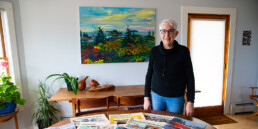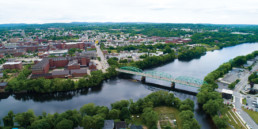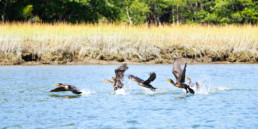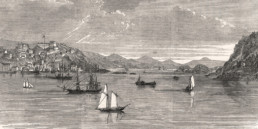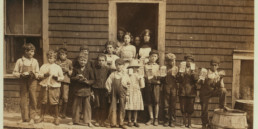A Community Unraveled:
The Legacy of Ireland’s Great Blasket Island
STORY AND PHOTOS BY KATHLEEN WALSH BUCHANAN
The Dingle Peninsula in County Kerry, Ireland, is a landscape of spare and emotive beauty. It is a rugged place of stone-walled fields climbing mountainsides to the limits of tillable land, where the Atlantic Ocean meets bold headlands with an almost unimaginable energy and intensity.
Irish poet and philosopher John O’Donohue’s words describe this corner of Ireland well: “There is a curvature of the landscape, a color and shape that constantly frustrate the eye anxious for symmetry or linear simplicity.”
Three miles off the western end of the Dingle Peninsula lies an archipelago of islands called the Blasket Islands. They are at the far edge of Ireland, with the great pyramidpeak of the island Tearacht forming the most westerly point in the country. The largest of the islands, the Great Blasket, gracefully curves upward from the Atlantic with skyline contours unobstructed by trees or structures. It is approximately three miles long on its east-west axis and a half-mile wide from north to south, rising to an elevation of almost 1,000 feet above the ocean.
Facing the mainland to the east and sheltered in the gently curving bowl of the mountainside lies an abandoned village that once sheltered a community of fishermen, farmers, and their families.
At its peak population in 1911, the village was home to approximately 160 people. In the years after World War I, emigration of the island’s youth, the decline of the fishing industry, and insufficient communication and transport to the mainland created vulnerability for the small community. The number of residents steadily declined, resulting in a largely aging population exposed to the extreme conditions on the island. Driven by increasing hardships and struggling to survive, in the late 1940s the islanders began to lobby the government to be relocated to homes on the mainland.
The eventual evacuation finally came in 1953, hastened by a tragic death. But the islanders’ story continued, with another chapter written in western Massachusetts.
Today, all that remains are the drystone walls of village homes and fields in various degrees of decay, and the roads and pathways that speak to the rhythms of a community and way of life that has disappeared from this beautiful place.
I first visited the Great Blasket Island in 2000 and was instantly captivated by the landscape. It was a point of transition in my life, having just made the decision to leave my job as a wildlife biologist to pursue an art career full-time, and I was using my time in Ireland to plan my path forward. With that goal guiding me, I found myself seeking quiet places, the edges and open spaces.
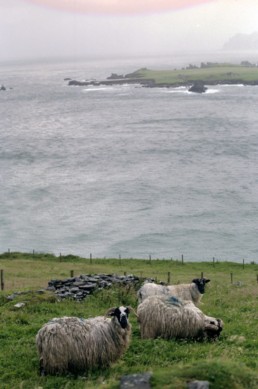
I visited the Great Blasket for a day, hopping on a ferry from the village of Dunquin over to the small landing on the island. I recall climbing the hill above the village, sketchbook in hand, marveling at the lines of the landscape—all rolling curves and vertiginous angles falling to the hard horizontal of the Atlantic horizon.
It is an island of unusual, almost surreal beauty. The complete lack of flat ground gives one a sense of being perpetually perched above the water, with the ground rolling away to the sea under your feet. Sheep belonging to mainland farmers graze the island, keeping the vegetation cropped close to the soil. Wild rabbits are so abundant that as you walk the hillsides, handfuls scatter from your path into burrows and under stones.
In the years since the village has been inhabited, significant colonies of shearwaters, auks, fulmars, and Atlantic gray seals have made the island their home. I left at the end of the day with a very fragmented sensory experience: the yielding softness of the turf underfoot, the sound of the wind roaring through a fulmar’s wings as it banked around me near the island summit, the shift of light and cloud, and the pure blue-green of the Atlantic. I left determined to spend time making artwork about the island, to integrate the patchwork of a day’s experience into a more meaningful whole.
The story of the Great Blasket and its community is one that is woven tightly into the Irish language. The Dingle Peninsula is part of the Gaeltacht, a region where Irish is recognized as the predominant language. Because of its relative isolation, the Irish spoken on the Great Blasket was a pure form of the language, uncorrupted by the English spoken throughout much of mainland Ireland.
In the early 20th century, this attracted linguistic scholars from throughout Europe to the island to study the language, and who in turn encouraged the islanders to record their way of life in writing. The result was the emergence of literary talent that captured the intimate structure of the community, the rhythm and cadence of conversation, and the cooperative nature of both work and social traditions.
Three islanders stand apart for their contribution to the island literature: Tomás O’Crohan (The Islandman, Island Cross-Talk), Maurice O’Sullivan (Twenty Years A-Growing), and Peig Sayers (Peig, and An Old Woman’s Reflections). Each is a unique voice, with individual perspectives on island life born from differences in age, gender, and experience. All three were gifted storytellers, with remarkable eyes for detail. What emerges are lyrical accounts of daily work on sea and land, the natural kinship of the islanders born of necessity and isolation, and both the joys and hardships of living on this exposed, wild island.
In The Islandman, published in 1934, O’Crohan writes with a keen awareness that the way of life of the Great Blasket community was slipping away: “I have written minutely of much that we did, for it was my wish that somewhere there should be a memorial of it all, and I have done my best to set down the character of the people about me so that some record of us might live after us, for the like of us will never be again.”
In effect, this became the island’s epitaph.
Four years after my first visit, I had the opportunity to return to the Great Blasket for an extended stay. Funded by a travel grant from the Connecticut-based Amity Art Foundation, the plan was to draw and photograph the island for a month and then return home to create a finished body of art from the field work. (As a printmaker, my work requires the use of a large etching press, and thus can’t be done outside.)
Arriving unceremoniously off the ferry from Dingle in driving wind and rain, my husband and I quickly created a home base within the remains of a village home, pitching our tent within the windbreak of the drystone walls. We adjusted quickly to the rhythm of life on the Great Blasket—rising early with the light, spending days hiking to the far reaches of the island, drawing sheep, seabirds, seals, and the landscape whenever the absence of rain allowed. We would lie on the turf at the tops of sea cliffs watching gannets, basking sharks, porpoises, auks. Everywhere there was color, light, and life to be recorded.
Evenings were centered on cooking a hot meal on the backpacking stove, making tea, and immersing ourselves in the voices of the island writers by the light of our headlamps. For me, it was an incredibly emotional experience to be walking the landscape and standing within the walls of homes where the island literature is rooted. It is unsettling to have the past and present intersect in such an incongruous way—to be immersed in a landscape that speaks of absence and a community unraveled, and yet to have the voices of the villagers present all around you. It is like standing quietly in the presence of souls.
Every night, after sleeping for a few hours, we would be awakened around midnight by the cries of Manx shearwaters returning to their colony on the island. It is a difficult sound to describe—not at all bird-like, but rather a raspy, wheezing, mournful wail. We would crawl out of our sleeping bags into the wind and point our headlamps into the blackness above, hoping to catch a glimpse of the elusive seabirds that sounded as though they were circling just above our heads. We were never able to see them; their voices were all we had.
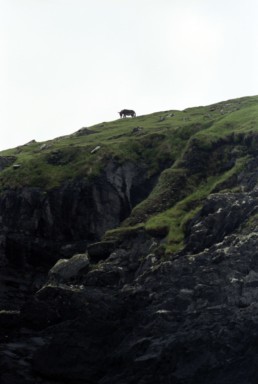
I left the island at the end of the month with sketchbooks and head full, and spent the next two years creating 25 editions of collagraph prints from my time there. The work was exhibited throughout New England and New York, and I still feel great fondness for the project that helped me establish my printmaking career. In the course of exhibiting the work, I was always surprised by the number of people I met who either have a personal or family connection to the Great Blasket, or who feel a kinship through the island literature. It is a place that is truly beloved by many.
Michael Carney at his home in East Longmeadow, Massachusetts.
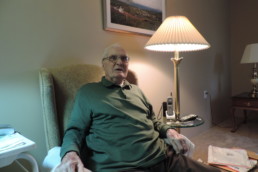
Perhaps no one personifies this dedication to the Great Blasket more than Dr. Michael Carney. In the early 20th century, a dozen or so islanders emigrated to my hometown of Springfield, Massachusetts, following each other’s path toward economic opportunity, and seeking to plant roots in America near family and familiar faces from the island. Michael was part of this tradition, leaving the island in 1937 in search of work and social opportunity.
He spent his childhood and early teen years on the island, eventually moving to Cahersiveen briefly, then Dublin, and in 1948, to the United States, settling in Springfield. Three of his father’s brothers had emigrated from the island to Springfield in the 1920s, thus giving him social and family support upon his arrival. His memoir, From the Great Blasket to America, was published in 2013, adding the emigrant perspective to the canon of island literature.
I sat down with him in December 2014 at his home, with Raidió na Gaeltachta (Irish language public radio) playing quietly in the background. The walls of his living room were decorated with photos and paintings of the Great Blasket, and I was welcomed warmly to sit beside him and talk about the island.
At 94, Michael has lived the majority of his life in America, but his voice still holds the soft accent of a native Irish speaker. We thumbed through my photographs of the island, letting the familiar landmarks of his childhood home spark stories of island life. He is quick with his humor, and a vivid storyteller whose absolute dedication to the Great Blasket is quickly apparent.
He spoke to me about the unique character of the community where he was raised.
“As children, you had to create your own pastimes. We would snare rabbits to eat, setting the snares on their runways. We would collect gull eggs from Beginish. You had to watch your head as you collected them, with the gulls swooping down at you. You played football on the strand—our ball was made of old socks stuffed with grass. There was tug-of-war, dancing, storytelling . . .
“[Islanders] never complained about helping each other. You became one family, because otherwise you had no reason to be there. My father had a flock of seventy to eighty sheep, and we would farm potatoes, cabbage, and turnip. If someone ran short we would share. When you had to borrow something like milk, tea, or sugar when you ran short, the first thing you would do is return it when you got more. You never owed anyone anything.”
In the wake of World War II, opportunities for emigration and employment off the Great Blasket were abundant. With the island’s youth emigrating, insecurity in fishing, and the closure of the island school, the community structure had become extremely vulnerable. Young people from the mainland were reluctant to marry into island families, as the conditions were so challenging and the island’s future seemed so uncertain. Few young people remained, and those who did struggled to find a way to support themselves on the island.
The winter of 1946–47 brought some of the harshest conditions that the islanders had seen in recent years. Their only transportation to and from the island was the traditional naomhóg, a small canvas-on-frame rowing vessel, and the only way to communicate with the mainland was a single battery-operated telephone with unreliable service. The rough weather resulted in complete isolation.
In December of 1946, Michael’s younger brother Seán fell ill. Unable to communicate with the mainland or reach a doctor due to the rough seas, Seán died on January 9, 1947, of meningitis. He was 24 years old. The prolonged tragedy of the young man’s death proved to be a pivotal point for the community.
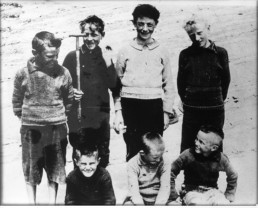
Island boys stand for a photo on the beach called “An Trá Bán,” which translates from Irish to “The White Strand.” Michael Carney is standing in the back on the left, and three of his brothers—Tom, Martin, and Paddy—are sitting in front.
Courtesy of OPW Great Blasket Centre
In his memoir, Michael writes, “It all seemed so senseless. The islanders came to the conclusion that it was no place for them to live. Essentially, Seán’s death and the circumstances broke the will of the islanders to continue living on the island. It was time to move on.”
From his home in Dublin, Michael played a major role in lobbying the Irish government to help relocate the remaining islanders to the mainland, writing to the Taoiseach (Prime Minister of Ireland) Éamon de Valera about Seán’s death and the hardships facing the community, and asking for property on the mainland to relocate the remaining islanders.
He also approached members of the Irish Parliament, exerting pressure to get aid for the islanders. De Valera visited the island in July 1947 to see the conditions for himself, but did not act before being ousted from office in 1948. This resulted in six years of frustration for the islanders, with the new Taoiseach, John Costello, not moving on behalf of the community. De Valera came back into office in 1951, and the government soon decided that all remaining islanders were to be moved to the mainland.
That came in 1953, with just 22 people living on the island. They were given homes and land in Dunquin, where they could fish and farm within view of the Great Blasket. Although islanders continued to raise sheep and spend some weeks of the summer on the island, the Great Blasket was essentially abandoned after the evacuation, the village left to the elements and the island to the seabirds and seals.
In the 1970s, property began to be purchased from former island families by an American developer with plans to create a resort on the Great Blasket. The plan eventually fell through, and in 1985 Michael learned that the Great Blasket was being advertised for sale in the Wall Street Journal for $900,000.
“Well, that’s when I started to get my Irish up,” he recalled. “I said, ‘Over my dead body.’ ”
The reaction in Ireland was similar, with many shocked at the potential private sale of a place that held such cultural significance.
West Kerry locals worked to establish the non-profit Blasket Island Foundation in 1987, with a mission to keep the spirit and memory of the island alive. From Springfield, Michael and the Blasket community supported this objective with fundraising efforts. The group funded a study on the creation of the Blasket Centre in Dunquin, which paved the way for the government to invest in the project. The Blasket Centre was built in 1993, and serves an important role in preserving the island legacy, drawing over 40,000 visitors each year.
The Blasket Island Foundation also has promoted efforts to preserve the island and, eventually, to create the Great Blasket Island National Historic Park. Michael has played a role in the process, meeting with members of the US Congress and two Irish presidents to promote preservation of the Great Blasket.
Moving the island from private to state ownership has been a slow and complex process. Presently, approximately 70 percent of the island is in government hands, and while the island is not yet officially a national park, Michael is hopeful that that day will come soon.
“There are only nine of us left—six in Ireland and three in Springfield,” he said, referring to the remaining native islanders. “When we all expire, I hope the government has taken over complete occupation of the island. Then I will sleep better.
“I feel the island has given so much. I would like the memory of the people there to not be forgotten,” he told me.
He paused, and quietly said, “I feel the island deserves this.”
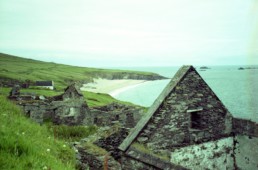
Kathleen Walsh Buchanan lives in Thomaston with her husband and two children. Her printmaking studio, Grey Seal Press, is named after the seal colony on Great Blasket Island. She will be returning to Ireland this fall for a residency fellowship at the Ballinglen Art Foundation, in Ballycastle, County Mayo.
Research sources:
From the Great Blasket to America, Michael Carney with Gerald Hayes (Collins Press, 2014)
The Islandman, Tomás O’Crohan (Talbot Press, 1934)
Anam Cara, John O’Donohue (HarperCollins, 1997)
The Blasket Islands: Next Parish America, Ray Stagles and Joan Stagles (O’Brien Press, 1998)

